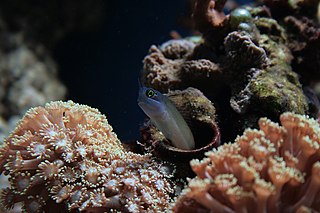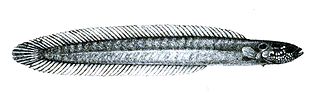
Labrisomids are small blennioids (blennies), percomorph marine fish belonging to the family Labrisomidae. Found mostly in the tropical Atlantic and Pacific Ocean, the family contains about 110 species in 15 genera.

The dottybacks are a family, Pseudochromidae, of fishes which were formerly classified in the order Perciformes, but this has been revised and the family is regarded as of uncertain affinities, or incertae sedis within the Ovalentaria, a clade within the Percomorpha. Around 152 species belong to this family.

Malacoctenus is a genus of labrisomid blennies native to the eastern Pacific Ocean and the Atlantic Ocean.

The carpet eel-blenny, also known as the green wolf eel or green wolf eel blenny, is a relatively large species of dottyback found in coastal parts of the Indo-West Pacific, including coral reefs, among rocks, seagrass beds, tidal flats and in brackish habitats. Despite the common names, it is unrelated to the true wolf eel of the North Pacific, the true eel of the order Anguilliformes and the true blennies of the suborder Blennioidei.

Alticus is a genus of combtooth blennies found in the Pacific and Indian oceans. It is one of 57 genera in the family Blenniidae.
Rhabdoblennius is a genus of combtooth blennies found in the Pacific Ocean, mostly in the western Pacific. The name of this genus is derived from the Greek word rhabdos meaning "stick" or "rod" and blennius meaning "mucus", referring to the absence of scales on the body of blennies.

Ecsenius melarchus, known commonly as the yellow-eyed comb-tooth or the Java combtooth-blenny in Indonesia, is a species of combtooth blenny in the genus Ecsenius. It is found in coral reefs in the western Pacific ocean. It can reach a maximum length of 5 centimetres. Blennies in this species primarily feed off of plants, including benthic algae and weeds, and are commercial aquarium fish. The specific name "melarchus" is Latin for "black anus", and refers to the black anal marking on the blennies in this species.
Ecsenius oculus, known commonly in Micronesia as the ocular blenny and as the coral blenny on Christmas Island, is a species of combtooth blenny in the genus Ecsenius. It is found in coral reefs in the western Pacific ocean. It can reach a maximum length of 7 centimetres. Blennies in this species feed primarily off of plants, including benthic algae and weeds, and are commercial aquarium fish.
Xiphasia matsubarai, the Japanese snake blenny, is a species of combtooth blenny found in the western Pacific and Indian oceans just extending into the Atlantic Ocean in False Bay, South Africa. This species can be found at depths ranging from the surface to 4,960 m (16,270 ft). This species reaches 30 cm (12 in) in SL. This species feeds primarily on bony fish, rising to the surface at night to feed. It can also be found in the aquarium trade.

Starksia is a genus of labrisomid blennies native to the western Atlantic Ocean and the eastern Pacific Ocean. Their typical length is 2 cm (0.79 in) SL. The generic name honours the American ichthyologist Edwin Chapin Starks (1867-1932) of Stanford University for his work on Pacific coastal fishes. As a genus Starksia is distinguished from other labrisomids by their scaled bodies, two obvious soft rays in the pelvic fin and the male's have an intromittent organ which is near to or attached to the first spine of their anal fins, which is also somewhat separated from the fin.

Ophidion is a genus of cusk-eels.

Congrogadinae is a subfamily of ray-finned fishes, one of four subfamilies that make up the family Pseudochromidae, these elongated fish are commonly called eel-blennies.

The ocellate eel blenny is a species of ray-finned fish from the subfamily Congrogadidae, which is in the family Pseudochromidae. It is the only species in the monospecific genus Blennodesmus. It is found along the northern coasts of Australia, from Western Australia, along the coast of the Northern Territory to Queensland. The ocellate eel blenny is found among coral rubble and occurs in intertidal pools up to a depth of 3 metres (9.8 ft) where it feeds mostly on crustaceans. Like other species of Congrogadid the ocellate eel blenny has eggs covered in hooks, cross shaped hooks in this species. This species has an extremely elongated body, its gill membranes are joineded to the isthmus ventrally. It has one, short lateral line which runs from its shoulder to underneath the front part of the dorsal fin. The body is dark brown in colour with mottled with paler markings and it has a black eyespot, smaller than its eye, located above the opercle. It grows to a maximum length of 8.9 centimetres (3.5 in) standard length.

Congrogadus is a genus of ray-finned fishes, the type genus of the subfamily Congrogadinae, the eel blennies, part of the dottyback family, Pseudochromidae. The genus Congrogadus has an Indo-Pacific distribution.
Halidesmus is a genus of ray-finned fishes, the type genus of the subfamily Congrogadinae, the eel blennies, part of the dottyback family, Pseudochromidae. They are found in the western Indian Ocean as far east as India, with one species extending marginally into the south-east Atlantic Ocean.
Halimuraena is a genus of ray-finned fishes, classified under the subfamily Congrogadinae, the eel blennies, part of the dottyback family, Pseudochromidae. They are found in the western Indian Ocean as far east as the Mascarene Islands, and north to Kenya, although the centre of the genus's distribution appears to be around Madagascar and the Mozambique Channel.
Natalichthys is a genus of ray-finned fishes, classified under the subfamily Congrogadinae, the eel blennies, part of the dottyback family, Pseudochromidae. They are found in the western Indian Ocean off the eastern coast of South Africa, the genus being named after Natal, where all three species in the genus are so far restricted to.
Rusichthys is a genus of ray-finned fishes, classified under the subfamily Congrogadinae, the eel blennies, part of the dottyback family, Pseudochromidae, from the western Indian Ocean. The generic name is a compound of the acronym RUSI which stands for Rhodes University Smith Institute and thus honours the South African ichthyologist James Leonard Brierley Smith








